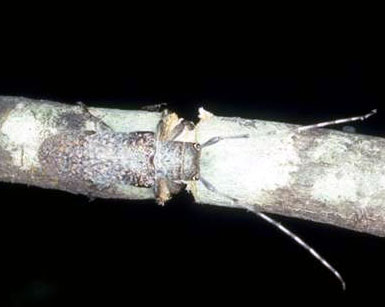Twig girdler
Oncideres cingulata
Natural History

Adult twig girdler and damage to twig
Photo credit: Lacy L. Hyche, Auburn University
The twig girdler (Oncideres cingulata) is a long-horned, wood-boring beetle that lives in many hardwoods in Florida but does not cause serious damage. Trees can become forked and deformed as a result of the females' egg laying process. Pecan groves and ornamental trees can be seriously affected in some cases.
In late summer, after mating occurs, female twig girdlers select a small twig of about 3/8" diameter and covered with just a thin layer of bark. The female beetle chews around the entire outside of the twig until the twig is almost separated from the tree. This causes part of the twig to die and this process is called girdling.
The female beetle then gnaws a small notch in the dead or dying part of the twig and lays her eggs in this notch. When the eggs hatch, the emerging larvae continue to live in the twig, feeding on the dead wood of the twig. The larvae grow and eventually construct a mass of frass in which they pupate. After they pupate, the larvae change into adult beetles and chew their way out of their twig. Adult beetles fly away to new host trees.
Most twigs that are girdled fall off the host tree due to wind and other forces. Few girdled twigs remain as part of the host tree. Twig girdler eggs will hatch and the larvae will develop in either case; it does not matter whether the twigs are on the ground or still hanging on the tree. The female beetles must girdle the twigs because the larvae cannot fully develop in green twigs with high moisture content. Each female twig girdler can attack dozens of shoots.
